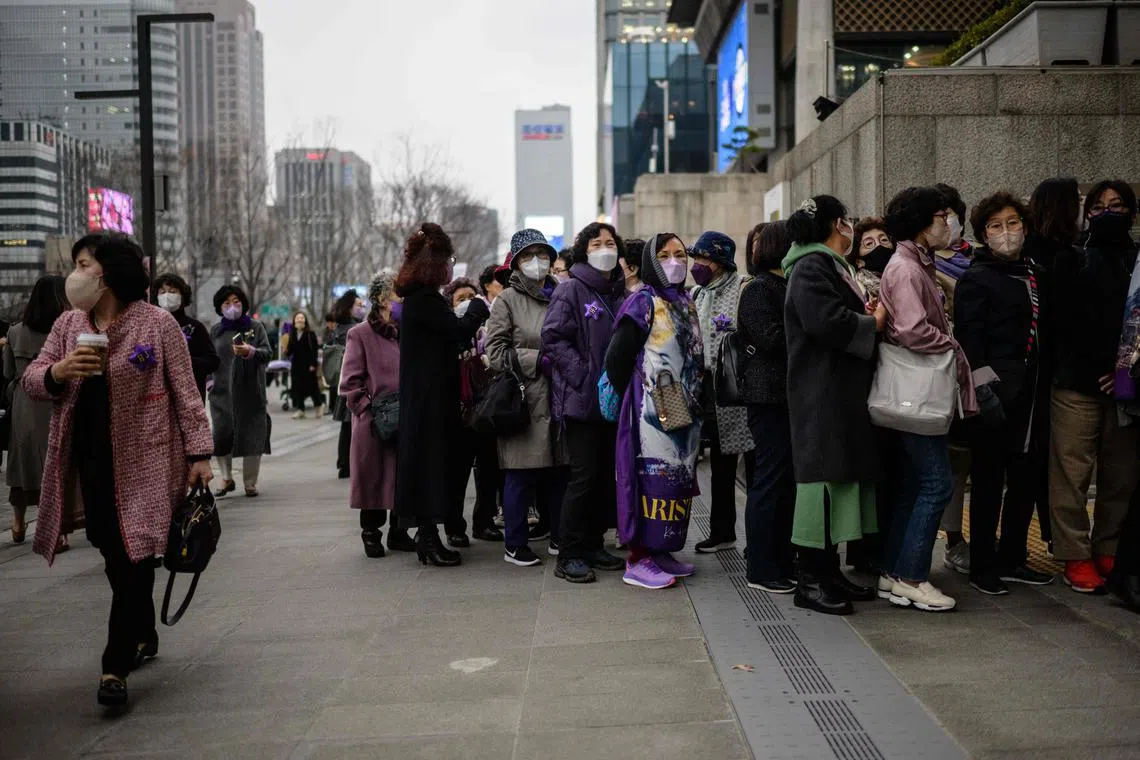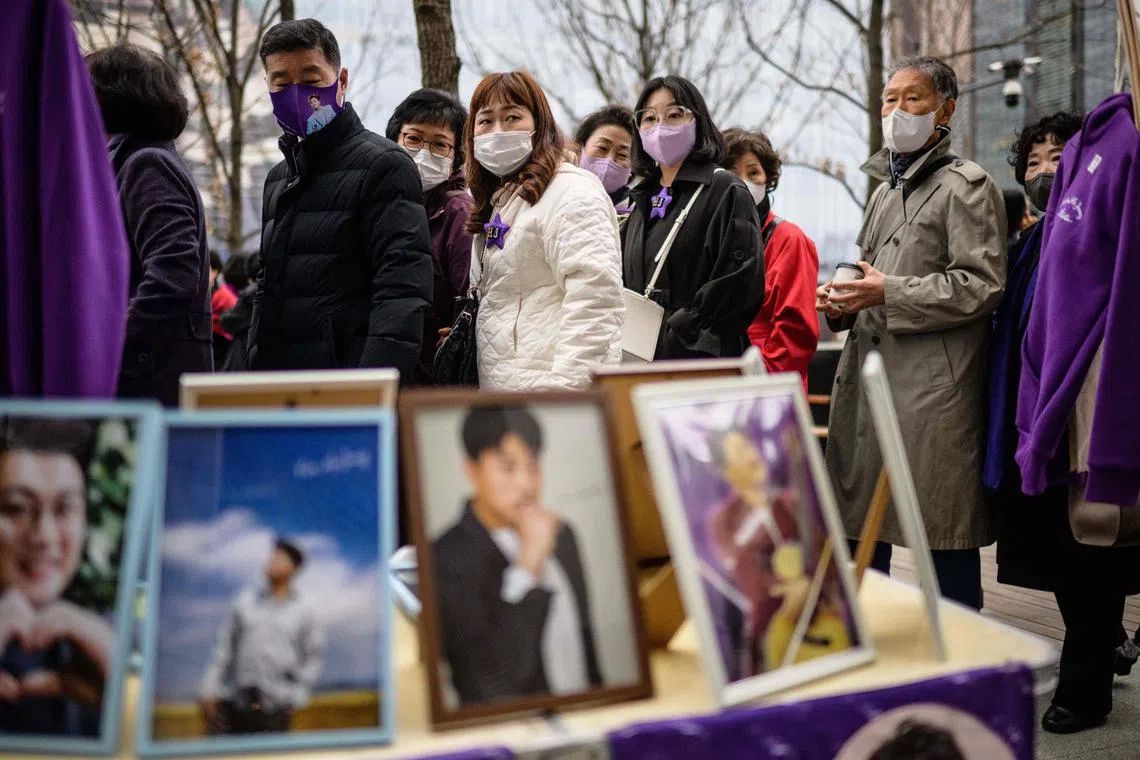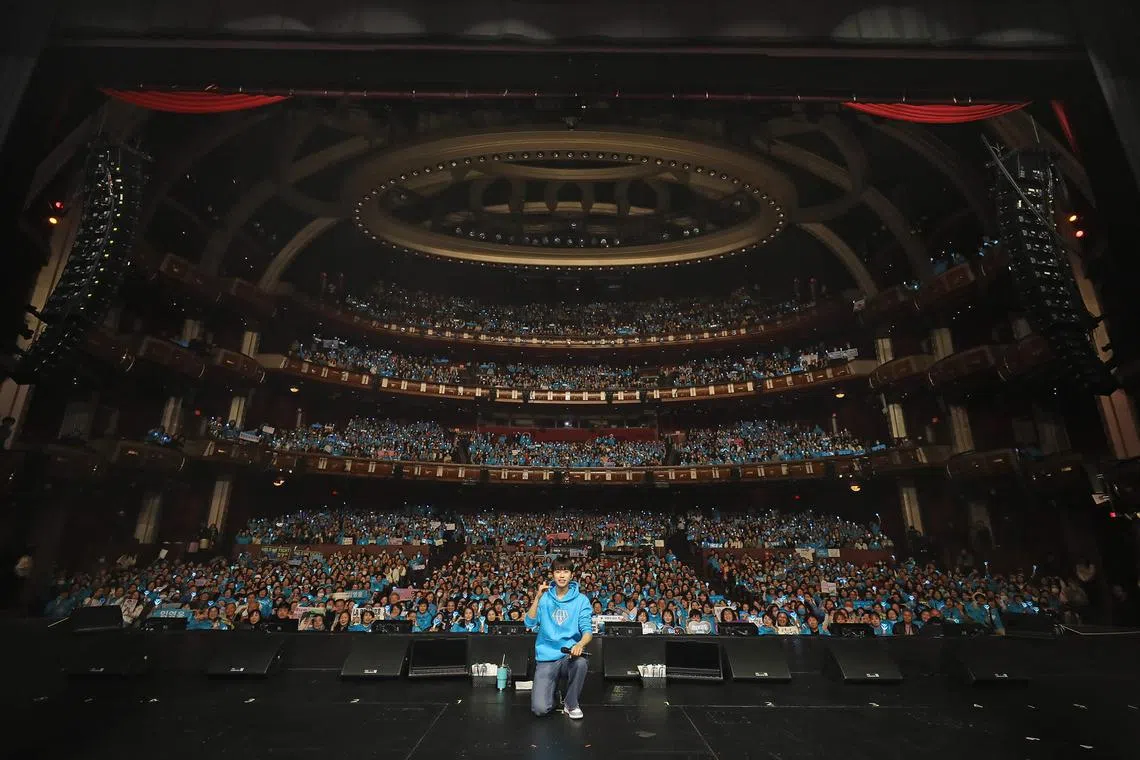New force in South Korean entertainment industry: Middle-aged women
Sign up now: Get ST's newsletters delivered to your inbox

Fans in their 50s, 60s and older have proven to be a force with real purchasing power and time in the past three years.
PHOTO: AFP
Follow topic:
SEOUL - On March 15, fans clad in purple crowded Sejong Centere for the Performing Arts near Gwanghwamun, central Seoul. Some wore purple clothes, while others wore purple hats, scarves, brooches – anything purple representing their beloved singer.
The colour, enthusiasm and dedication of these fans immediately brought to mind BTS’ fan community, Army. But what set these particular fans apart was something truly remarkable – their age.
According to the 2022 BTS Army Census, a survey of BTS Army members, 30.3 per cent were under 18, 53.63 per cent were aged 18 to 29, 9.31 per cent were aged 30 to 39, and only 6.75 per cent were aged 40 or over.
On that particular day, those in purple were Aristra, fans of 31-year-old singer Kim Ho-joong, who emerged as a star from TV Chosun’s Mr Trot show in 2020.
At the Sejong Centre, the first classical music concert of the trot singer, who was originally trained in classical voice, was about to take place. Excitement filled the air as fans eagerly lined up, hoping to secure last-minute cancelled tickets for the two-day concert.
“I used to live next to Jamsil (where large-scale concerts often take place). When I saw young people flooding in on rented buses from all around the country, I felt sorry for their parents,” Ms Choi Young-sil, a fan of Mr Kim’s since 2020, told The Korea Herald. “Little did I know then that I myself would be travelling on a rental bus to follow my favourite singer’s concerts around the country.”
Ms Choi has always loved music but with Mr Kim, she turned into a very dedicated fan in her late 60s.
She would attend almost all of Mr Kim’s concerts around the country and visit places that Mr Kim visited, although she was too late to reserve a spot on a cruise, where tickets cost US$2,000 to US$3,000 (S$2,687 to S$4,030) apiece and sold out quickly.
A group of 3,000 fans left the port of Pohang on June 5 for a seven-day cruise trip that will visit Japan and Taiwan.
“His songs and life story are truly inspiring. Many fans get energy from him,” Ms Choi said.
Ms Choi was in her late 40s back when Korean actor Bae Yong-joon took Japan by storm following the airing of “Winter Sonata” in 2003, backed by Japanese women in their 40s, 50s and older.
Like many others in South Korea, she thought the “Yonsama (Bae’s nickname in Japan)“ phenomenon – which led huge numbers of Japanese tourists to Korea – was interesting but nothing more than that.

Fans queue up to attend a performance by singer Kim Ho-joong in Seoul on March 15,.
PHOTO: AFP
Times have changed, and these middle-aged fans are fully involved in supporting their idols in every way possible and their commitment and enthusiasm for their favourite artists rival those of fans of K-pop stars.
Like K-pop fans, they adorn buses with their singer’s photo while traversing the country, as well as pay for advertisements to be displayed in subway stations to celebrate their singer’s birthday or new album releases.
These devoted fans even make donations in the name of their beloved musicians to help those in need. They actively participate in volunteer work, proudly representing their fan community.
The ultimate display of their devotion can be seen in the form of streets named after their cherished musicians like the 400 m long Kim Ho-joong Sound Street in Gimcheon-si, North Gyeongsang Province, where he went to Gimcheon High School of Arts.
Fans in their 50s, 60s and older have proven to be a force that moves South Korea’s entertainment business with real purchasing power and time in the past three years.
On April 8, Mr Lim Young-woong, 31, appeared for the ceremonial kick-off at the Seoul World Cup Stadium in front of more than 45,00 fans.
The news of his appearance brought many middle-aged women to a football stadium for the first time in their lives, creating the largest crowd since the K League started tallying paying spectators in 2018.
Mr Lim has established himself as one of the most influential singers in Korea. From Jan 7, 2022 to Jan 7, 2023, he garnered a staggering 390 million views on YouTube, which put him No. 2 in South Korea, behind IU and followed by BTS, in terms of numbers of views.
Mr Lim reportedly earns 30 billion won (S$31.22 million) to 40 billion won from music streaming.

Singer Lim Young-woong has established himself as one of the most influential singers in Korea.
PHOTO: 임영웅/FACEBOOK
To boost streaming views, fans share their know-how on how to run their idol’s songs on multiple platforms at the same time, according to fans.
“A fan in her 80s asked me what she could do for the singer she loves other than purchasing an album, so I taught her how to stream his songs on YouTube, Melon, Genie Music and Vibe,” a fan who wishes to remain anonymous told The Korea Herald.
“Producers in the pop culture industry must have realised the enormity of the middle-aged market and the astonishing potential of this new type of fan community,” Jowi, the author of “Why do we love Lim Young-woong?” told The Korea Herald. Jowi is a pen name.
Jowi wrote the book after deciding the popularity of Mr Lim is something unique and makes people unite based on having similar experiences of feeling healed when listening to his songs.
“Within this fan community comprising middle-aged individuals, there is a growing awareness that their actions can bring about changes in the music industry and market landscape. This realisation that ‘we can change the market’ can serve as a small driving force that enriches these fans’ lives,” the author said. THE KOREAN HERALD/ASIA NEWS NETWORK

